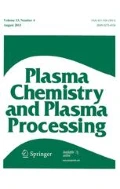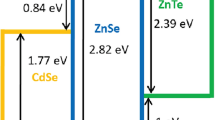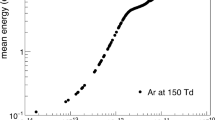Abstract
Corona discharge is a self-sustained discharge of gaseous medium in inhomogeneous electric fields, which often occurs on transmission lines and has some adverse effect on the power transmission system. In this paper, a kinetic model of corona discharges is presented to simulate the evolution process of charged particles and neutral species in humid air. To investigate the effect of humidity, our model consists of 69 species and 393 chemical reactions which consider important reactions containing H2O molecules and hydrates. In addition, CO2 molecules are also included to improve the integrity of reaction database. A temporal evolution of reduced electric field strengths E/N, which are typical experimental values of corona discharges, is used as input. The simulation results show that H3O+ is one of the dominant positive ions which is in qualitative agreement with previous experimental results. The effect of humidity and pulse width on the plasma chemistry is also discussed. It is found that the humidity affects the maximum density and life time of the specific species. Meanwhile, the plasma chemistry could be affected by different pulse widths of the input electric field.











Similar content being viewed by others
References
Maruvada PS (2000) Corona performance of high-voltage transmission lines. Research Studies Press, Baldock
Kuwahara T, Kuroki T, Yoshida K, Saeki N, Okubo M (2012) Development of sterilization device using air nonthermal plasma jet induced by atmospheric pressure corona discharge. Thin Solid Films 523:2–5
Černák M, Ráhel J, Kováčik D, Šimor M, Brablec A, Slavíček P (2004) Generation of thin surface plasma layers for atmospheric-pressure surface treatments. Contrib Plasma Phys 44:492–495
Messerle VE, Karpenko EI, Ustimenko AB (2014) Plasma assisted power coal combustion in the furnace of utility boiler: numerical modeling and full-scale test. Fuel 126:294–300
Van Deynse A, Cools P, Leys C, Morent R, De Geyter N (2015) Surface modification of polyethylene in an argon atmospheric pressure plasma jet. Surf Coat Technol 276:384–390
Kostov KG, Nishime TMC, Castro AHR, Toth A, Hein LRO (2014) Surface modification of polymeric materials by cold atmospheric plasma jet. Appl Surf Sci 314:367–375
Green DW, Perry RH, Maloney JO (1997) Densities of pure substances. Perry’s Chem Eng Handb 7:2–28
L. R. Group (1977) Positive Discharges in Long Air Gaps at Les Renardières–1975 Results and Conclusions. Electra 53:31–153
Meek MJ, Craggs JD (1978) Electrical breakdown of gases. Physics Bulletin 30(6):266
Peyrous R (1990) The effect of relative humidity on ozone production by corona discharge in oxygen or air—a numerical simulation—part II: air. Ozone Sci Eng 12:41–64
Alves LL, Bogaerts A, Guerra V, Turner MM (2018) Foundations of modelling of nonequilibrium low-temperature plasmas. Plasma Sources Sci Technol 27:023002
Gaens WV, Bogaerts A (2013) Kinetic modelling for an atmospheric pressure argon plasma jet in humid air. J Phys D Appl Phys 46:275201
Gaens WV, Bogaerts A (2014) Reaction pathways of biomedically active species in an Ar plasma jet. Plasma Sources Sci Technol 23:035015
Schmidt-Bleker A, Winter J, Iseni S, Dünnbier M, Weltmann KD, Reuter S (2014) Reactive species output of a plasma jet with a shielding gas device—combination of FTIR absorption spectroscopy and gas phase modelling. J Phys D Appl Phys 47:145201
Fu Y, Krek J, Parsey GM, Verboncoeur JP (2018) Characterizing the dominant ions in low-temperature argon plasmas in the range of 1–800 Torr. Phys Plasmas 25:033505
Cui Y, Zhuang C, Zhou X, Zeng R (2019) The dynamic expansion of leader discharge channels under positive voltage impulse with different rise times in long air gap: experimental observation and simulation results. J Appl Phys 125:113302
Waskoenig J, Niemi K, Knake N, Graham LM, Reuter S, Gathen VS-VD et al (2010) Atomic oxygen formation in a radio-frequency driven micro-atmospheric pressure plasma jet. Plasma Sources Sci Technol 19:045018
Kossyi IA, Matveyev AA et al (1992) Kinetic scheme of the non-equilibrium discharge in nitrogen-oxygen mixtures. Plasma Sources Science and Technology 1(3):207
Gentile AC, Kushner MJ (1995) Reaction chemistry and optimization of plasma remediation of NxOyfrom gas streams. J Appl Phys 78:2074–2085
Wang WZ, Patil B, Heijkers S et al (2017) Nitrogen fixation by gliding arc plasma: better insight by chemical kinetics modelling. Chemsuschem 10:2145–2157
Wang WZ, Snoeckx R, Zhang X, Cha MS, Bogaerts A (2018) Modeling plasma-based CO2 and CH4 conversion in mixtures with N2, O2, and H2O: the bigger plasma chemistry picture. J Phys Chem C 122:8704–8723
Sakiyama Y, Graves DB, Chang H-W, Shimizu T, Morfill GE (2012) Plasma chemistry model of surface microdischarge in humid air and dynamics of reactive neutral species. J Phys D Appl Phys 45:425201
Liu DX, Bruggeman P, Iza F, Rong MZ, Kong MG (2010) Global model of low-temperature atmospheric-pressure He + H2O plasmas. Plasma Sources Sci Technol 19:025018
Bobkova ES, Smirnov SA, Zalipaeva YV, Rybkin VV (2014) Modeling chemical composition for an atmospheric pressure DC discharge in air with water cathode by 0-D model. Plasma Chem Plasma Process 34:721–743
Murakami T, Niemi K, Gans T, O’Connell D, Graham WG (2014) Afterglow chemistry of atmospheric-pressure helium–oxygen plasmas with humid air impurity. Plasma Sources Sci Technol 23:025005
Murakami T, Niemi K, Gans T, O’Connell D, Graham WG (2013) Interacting kinetics of neutral and ionic species in an atmospheric-pressure helium–oxygen plasma with humid air impurities. Plasma Sources Sci Technol 22:045010
Flitti A, Pancheshnyi S (2009) Gas heating in fast pulsed discharges in N2–O2mixtures. Eur Phys J Appl Phys 45:21001
Dvonč L, Janda M (2015) Study of transient spark discharge properties using kinetic modeling. IEEE Trans Plasma Sci 43:2562–2570
Pancheshnyi S, Eismann B, Hagelaar G, Pitchford L (2008) Computer code ZDPlasKin. University of Toulouse, LAPLACE, CNRS-UPS-INP, Toulouse
Skalny JD, Orszagh J, Matejcik S, Mason NJ, Rees JA, Aranda-Gonzalvo Y et al (2008) A mass spectrometric study of ions extracted from point to plane DC corona discharge fed by carbon dioxide at atmospheric pressure. Int J Mass Spectrom 277:210–214
Skalny JD, Orszagh J, Mason NJ, Rees JA, Aranda-Gonzalvo Y, Whitmore TD (2008) Mass spectrometric study of negative ions extracted from point to plane negative corona discharge in ambient air at atmospheric pressure. Int J Mass Spectrom 272:12–21
Morgan L. Plasma chemistry modeling—KINEMA research and software LLC. http://kinema.com/plasma-chemistry-modeling/
Hokazono H, Obara M, Midorikawa K, Tashiro H (1991) Theoretical operational life study of the closed-cycle transversely excited atmospheric CO2 laser. J Appl Phys 69:6850–6868
Gravendeel B, de Hoog FJ (1987) Clustered negative ions in atmospheric negative corona discharges in the Trichel regime. J Phys B: Atom Mol Phys 20(23):6337
Sakata S, Okada T (1994) Effect of humidity on hydrated cluster-ion formation in a clean room corona discharge neutralizer. J Aerosol Sci 25(5):879–893
Nagato K, Matsui Y, Miyata T, Yamauchi T (2006) An analysis of the evolution of negative ions produced by a corona ionizer in air. Int J Mass Spectrom 248:142–147
Sieck LW, Herron JT, Green DS (2000) Chemical kinetics database and predictive schemes for humid air plasma chemistry: Part I: Positive ion–molecule reactions. Plasma Chem Plasma Process 20(2):235–258
G. J. M. Hagelaar. (2013). Bolsig+: Electron Boltzmann equation solver. http://www.bolsig.laplace.univ-tlse.fr/how2use.php
Phelps AV, Pitchford LC (1985) Anisotropic scattering of electrons by N2 and its effect on electron transport. Phys Rev A 31:2932–2949
Pancheshnyi S, Biagi S, Bordage MC, Hagelaar GJM, Morgan WL, Phelps AV et al (2012) The LXCat project: electron scattering cross sections and swarm parameters for low temperature plasma modeling. Chem Phys 398:148–153
(26 May 2014) Morgan Database (online). http://www.lxcat.net
(13 March 2014) Phelps Database (online). http://www.lxcat.net
Horenstein MN (1984) Computation of corona space charge, electric field, and VI characteristic using equipotential charge shells. IEEE transactions on industry applications. 1A–20:1607–1612
Maruvada PS, Dallaire R, Heroux P, Rivest N (1984) Long-term statistical study of the corona electric field and ion-current performance of a ± 900-kV bipolar HVDC transmission line configuration. IEEE Trans Power Apparatus Syst 103:76–83
Hidaka K, Fujita H (1982) A new method of electric field measurements in corona discharge using Pockels device. J Appl Phys 53:5999–6003
Chang J-S, Lawless PA, Yamamoto T (1991) Corona discharge processes. IEEE Trans Plasma Sci 19:1152–1166
Shahin M (1969) Nature of charge carriers in negative coronas. Appl Opt 8:106–110
Skalny JD, Mikoviny T, Matejcik S, Mason NJ (2004) An analysis of mass spectrometric study of negative ions extracted from negative corona discharge in air. Int J Mass Spectrom 233:317–324
Pavlik M, Skalny JD (1997) Generation of [H3O]+∙(H2O)n clusters by positive corona discharge in air. Rapid Commun Mass Spectrom 11(16):1757–1766
Shahin MM (1966) Mass-spectrometric studies of corona discharges in air at atmospheric pressures. J Chem Phys 45:2600–2605
Held B, Peyrous R (1999) Physical and chemical studies of corona discharges in air. Czechoslov J Phys 49(3):301–320
Hill CA, Thomas CLP (2003) A pulsed corona discharge switchable high resolution ion mobility spectrometer-mass spectrometer. The Anal 128:55–60
Acknowledgements
The research was supported by National Natural Science Foundation of China (51607061, 51677061) and Fundamental Research Funds for the Central Universities (531118040072).
Author information
Authors and Affiliations
Corresponding author
Additional information
Publisher's Note
Springer Nature remains neutral with regard to jurisdictional claims in published maps and institutional affiliations.
Appendix: Reaction List
Appendix: Reaction List
Table 2 lists all chemical reactions considered in this paper. Rate coefficients are in units of s−1, cm3 s−1 and cm6 s−1 for one, two, and three-body reactions, respectively. The ion temperature Ti (K) is given by
where αi = 0.13 K Td−2. The effective temperature of ions colliding with neutrals is defined as
where mi and mj are the masses of the ion and neutral components involved in the reaction.
Rights and permissions
About this article
Cite this article
Wang, L., Chen, S. & Wang, F. Kinetic Modelling of Atmospheric Pressure Corona Discharges in Humid Air. Plasma Chem Plasma Process 39, 1291–1315 (2019). https://doi.org/10.1007/s11090-019-10006-9
Received:
Accepted:
Published:
Issue Date:
DOI: https://doi.org/10.1007/s11090-019-10006-9




